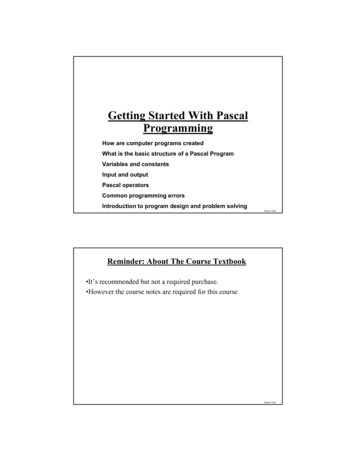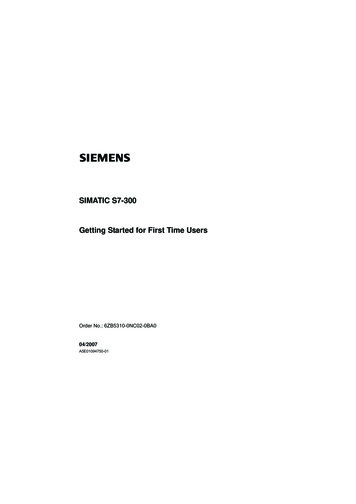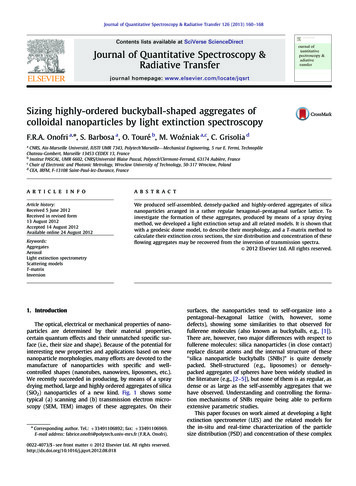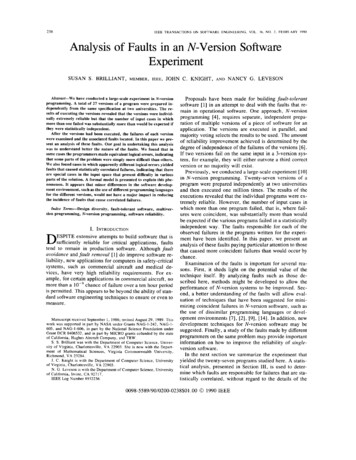
Transcription
Getting Started With PascalProgrammingHow are computer programs createdWhat is the basic structure of a Pascal ProgramVariables and constantsInput and outputPascal operatorsCommon programming errorsIntroduction to program design and problem solvingJames TamReminder: About The Course Textbook It’s recommended but not a required purchase. However the course notes are required for this courseJames TamGetting Started With Pascal Programming1
Reminder: How To Use The Course Resources They are provided to support and supplement this class. Neither the course notes nor the text book are meant as asubstitute for regular attendance to lecture and the tutorials.James TamReminder: How To Use The Course Resources (2)procedure add (var head: NodePointer;var newNode : NodePointer);vartemp : NodePointer;beginif (head NIL) thenhead : newNodeelsebegintemp : head;while (temp .next NIL) dotemp : temp .next;temp .next : newNode;end;newNode .next : NIL;end;James TamGetting Started With Pascal Programming2
Reminder: How To Use The Course Resources (2)eprocedure add (var headak on : NodePointer;mvar: NodePointer);ps newNodevarlas ch u tcaat ge s)temp :sNodePointer;s ou c ed ( oteibeginm t y ss s ni thenasouif (headyth u mNIL)claIf re heados: newNode’ysu at neh eowelsembeginsotemp : head;while (temp .next NIL) dotemp : temp .next;temp .next : newNode;end;newNode .next : NIL;end;.wcla hensu ss m yoyo pple ak u doain ur o me e su mant h t go w n t t h r e t h k e ie e n no etxa na tes slid at yo toms reeu(if y mem caus s witou be e y hdo r it oun’t in)James TamBut Once You’ve Made An Attempt To Catch Up Ask for help if you need it There are no dumb questionsImage from “The Simpsons” FoxGetting Started With Pascal ProgrammingJames Tam3
Don’t Forget: How To Succeed In This Course1.2.3.4.Practice things yourselfMake sure that you keep up with the materialLook at the material before coming to lectureStart working on things earlyJames TamComputer ProgramsBinary is the language of the computerTranslatore.g., gpc1) A programmerwrites a computerprogram2) A translatorconverts theprogram into aform that thecomputer canunderstand3) Anexecutableprogram iscreated4) Anybody who hasthis executableinstalled on theircomputer can run(use) it.James TamGetting Started With Pascal Programming4
TranslatorsConvert computer programs to machine languageTypes1) Interpreters Each time that the program is run the interpreter translates the program(translating a part at a time).If there are any errors during the process of interpreting the program, theprogram will stop running right when the error is encountered.2) Compilers Before the program is run the compiler translates the program (compiling it allat once).If there are any errors during the compilation process, no machine languageexecutable will be produced.If there are no errors during compilation then the translated machine languageprogram can be run.James TamCompiling Programs: Basic ascalcompilerinputgpcoutputa.outJames TamGetting Started With Pascal Programming5
The Smallest Pascal Programprogram smallest;beginend.Note: The name in the header "smallest" should match the filename "smallest.p". Youcan find an online version of this program in the Unix file system under/home/231/examples/intro/smallest.p (the compiled version is called "smallest").James TamCreating And Compiling Programs On TheComputer Science NetworkTo begin creating the Pascal programin Unix type "XEmacs filename.p"Text editorXEmacsPascal programfilename.p(Unix file)PascalcompilergpcMachine languageprogramTo compile the program inUnix type "gpc filename.p"a.out (Unixfile)To run the program in Unixtype "./a.out"James TamGetting Started With Pascal Programming6
Source Code Vs. Executable FilesSource code (e.g., smallest.p file) A file that contains the Pascal program code.It must end with a ‘dot-p’ suffix (program name.p).Can be viewed and edited.Cannot be executed.program smallest;begin::end.Executable code (often it’s the “a.out” file) A file that contains machine language (binary) code.By default this file will be called “a.out”.It cannot be directly viewed or edited (meaningless).It can be executed.ELF A B A @ @ @ @ @ @ @ @ @ @ B @ B @ @ @ A @ A Zh @ @ @4 @ B\263\370 @ @ @ @ @4 @ @ E @( @ ] @ Z @ @ @ F @ @ \::James TamBasic Structure Of Pascal ProgramsProgram name.p (Pascal source code)Part I: HeaderProgram documentationprogram name (input, output);Part II: Declarationsconst:Part III: Statementsbegin:end.James TamGetting Started With Pascal Programming7
Details Of The Parts Of A Pascal ProgramPart I: Header Parts:1) Program documentation- Comments for the reader of the program (and not the computer)(**)Marks the beginning of the documentationMarks the end of the documentation2) Program heading- Keyword: program, Name of program, if input and/or output operationsperformed by the program. Example(** Tax-It v1.0: This program will electronically calculate your tax return.* This program will only allow you to complete a Canadian tax return.*)program taxIt (input, output);DocumentationHeadingJames TamProgram DocumentationProgram documentation: Used to provide information about acomputer program to another programmer: Often written inside the same file as the computer program (when you seethe computer program you can see the documentation). The purpose is to help other programmers understand how the program codewas written: how it works, what are some of it’s limitations etc.User manual: Used to provide information about how to use aprogram to users of that program: User manuals are traditionally printed on paper but may also be electronicbut in the latter case the user manual typically takes the form of electronichelp that can be accessed as the program is run. The purpose is to help users of the program use the different features of theprogram without mention of technical details.James TamGetting Started With Pascal Programming8
Program Documentation (2) It doesn’t get translated into binary. It doesn’t contain instructions for the computer to execute. It is for the reader of the program: What does the program do e.g., tax program. What are it’s capabilities e.g., it calculates personal or small business tax. What are it’s limitations e.g., it only follows Canadian tax laws and cannotbe used in the US. What is the version of the program- If you don’t use numbers for the different versions of your program thenconsider using dates. How does the program work.- This is often a description in English (or another high-level) language thatdescribes the way in which the program fulfills its functions.- The purpose of this description is to help the reader quickly understand how theprogram worksJames TamDetails Of The Parts Of A Pascal Program (2)Part II: Declarations List of constants More to come later during this term regarding this sectionPart III: Statements The instructions in the program that actually gets things doneThey tell the computer what to do as the program is runningStatement are separated by semicolons ";“Example statements: display a message onscreen, prompt the user for input,open a file and write information to that file etc. Much more to come later throughout the rest of the term regarding thissectionJames TamGetting Started With Pascal Programming9
Performing CalculationsOperationSymbol (Operator)Addition Subtraction-Multiplication*Real number division/Integer divisionDIVRemainder (modulo)MODJames TamStoring InformationInformationCould it change?(Use a variable)Never changes.(Use a named constant)James TamGetting Started With Pascal Programming10
VariablesSet aside a location in memory This location can store one ‘piece’ of informationUsed to store information (temporary) At most the information will be accessible as long as the program runsTypes: integer – whole numbers real – whole numbers and fractions char – a single character: alphabetic, numeric and miscellaneous symbols(in UNIX type “man ascii”) boolean – a true or false valueUsage (must be done in this order!) Declaration Accessing or assigning values to the variablesPicture from Computers in your future by Pfaffenberger BJames TamDeclaring VariablesSets aside memoryMemory locations are addressed through the name of the variableRAMName ofvariableRESERVEDJames TamGetting Started With Pascal Programming11
Declaring VariablesDeclare variables between the ‘begin’ and ‘end.’Part I: HeaderProgram documentationprogram name (input, output);Part II: Declarationsconst:Part III: StatementsbeginDeclare variables here (just after the ‘begin’end.James TamDeclaring Variables (3)Format:var name of first variable : type of first variable;var name of second variable : type of second variable;Example:The full example can be found in UNIX under:/home/231/examples/intro/variableExample1.p (variableExample1 for thecompiled version).program variableExample1;beginvar height : real;Variablevar weight : real;declarationvar age: integer;end.James TamGetting Started With Pascal Programming12
Global Variables Variables declared outside of the begin-end pair.program anExample;var num1 : integer;beginvar num2 : integer;Global variable: DON’T DOIT THIS WAYNon-global variable (localvariable): DO IT THIS WAYend. For now avoid doing this (additional details will be providedlater in the course): generally this is regarded as badprogramming style.James TamVariable Naming Conventions Should be meaningful Any combination of letters, numbers or underscore (can'tbegin with a number and shouldn't begin with an underscore) Can't be a reserved word (see the “Reserved Words” slide) Avoid using predefined identifiers (see the “StandardIdentifiers” slides) Avoid distinguishing variable names only by case For variable names composed of multiple words separate eachword by capitalizing the first letter of each word (save for thefirst word) or by using an underscore.James TamGetting Started With Pascal Programming13
Reserved WordsHave a predefined meaning in Pascal that cannot be whilewhileFor more information on reserved words go to the url: http://www.gnu-pascal.de/gpc/index.htmlJames TamStandard IdentifiersHave a predefined meaning in Pascal that SHOULD NOT be changedPredefined constants false true maxintPredefined types booleancharintegerrealtextPredefined files input outputFor more information on standard identifiers go to the url: http://www.gnu-pascal.de/gpc/index.htmlGetting Started With Pascal ProgrammingJames Tam14
Standard Identifiers (2)Predefined dsinsqrsqrtsucctruncFor more information on standard identifiers go to the url: http://www.gnu-pascal.de/gpc/index.htmlJames TamStandard Identifiers (3)Predefined ewriteunpackwritewritelnFor more information on standard identifiers go to the url: http://www.gnu-pascal.de/gpc/index.htmlGetting Started With Pascal ProgrammingJames Tam15
Variable Naming Conventions (2) Okay:- tax rate- firstName Not Okay (violate Pascal syntax)-1abctest.msggood-dayprogram Not okay (bad style)- x- writelnJames TamAccessing VariablesCan be done by referring to the name of the variableFormat:name of variableExample:numJames TamGetting Started With Pascal Programming16
Assigning Values To VariablesFormat:Destination : Source; 1Example:The full example can be found in UNIX under:/home/231/examples/intro/variableExample2.p (variableExample2 for thecompiled version).program variableExample2;beginvar height : real;var weight : real;var age: integer;weight : height * 2.2;end.NO!1 The source can be any expression (constant, variable or mathematical formula)James TamAssigning Values To Variables (2)program variableExample2;beginvar height : real;var weight : real;var age: integer;height : 69;A betterweight : height * 2.2;approachend.Important lesson: ALWAYS initialize your variables to somedefault starting value before using them.James TamGetting Started With Pascal Programming17
Assigning Values To Variables (3)Avoid assigning mixed types:program variableExample;beginvar num1 : integer;var num2 : real;num1 : 12;num2 : 12.5;num2 : num1;RareNot allowed!num1 : num2;end.James TamReminder: Variables Must First Be Declared BeforeThey Can Be Used! (The Right Way)Correct:RAMprogram anExample;beginvar num : integer;num : 888;end.num888James TamGetting Started With Pascal Programming18
Reminder: Variables Must First Be Declared BeforeThey Can Be Used! (The Wrong Way)Incorrect:RAMprogram anExample;beginnum : 888;var num : integer;CompileError:end.Where isnum?James TamNamed ConstantsA memory location that is assigned a value that CANNOT be changedDeclared in the constant declaration ("const") sectionThe naming conventions for choosing variable names generally apply toconstants but the name of constants should be all UPPER CASE. (You canseparate multiple words with an underscore).Format:constNAME OF FIRST CONSTANT value of first constant;NAME OF SECOND CONSTANT value of second constant;etc.James TamGetting Started With Pascal Programming19
Named Constants (2)Examples:constTAX RATE 0.25;SAMPLE SIZE 1000;YES True;NO False;James TamDeclaring Named ConstantsNamed constants are declared in the declarations sectionPart I: HeaderProgram documentationprogram name (input, output);Part II: DeclarationsconstDeclare constants herePart III: Statementsbegin::end.James TamGetting Started With Pascal Programming20
Named Constants: A Compilable Exampleprogram anExample;constTAX RATE 0.25;SAMPLE SIZE 1000;YES True;NO False;MY FIRST INITIAL ‘J’;beginvar grossIncome : real;var afterTaxes : real;grossIncome : 100000;afterTaxes : grossIncome – (grossIncome * TAX RATE);end.James TamPurpose Of Named Constants1) Makes the program easier to understandpopulationChange : (0.1758 – 0.1257) * currentPopulation;Vs.constMagic Numbers(avoid wheneverpossible!)BIRTH RATE 0.1758;DEATH RATE 0.1257;beginpopulationChange : (BIRTH RATE – DEATH RATE) *currentPopulation;James TamGetting Started With Pascal Programming21
Purpose Of Named Constants (2)2) Makes the program easier to maintain- If the constant is referred to several times throughout the program,changing the value of the constant once will change it throughout theprogram.James TamPurpose Of Named Constants (3)program population (output);constBIRTH RATE 0.1758;DEATH RATE 0.1257;beginvar populationChange : real;var currentPopulation : real;populationChange : (BIRTH RATE - DEATH RATE) * currentPopulation;if (populationChange 0) thenwriteln(‘Births: ‘, BIRTH RATE, ‘ Deaths:’, DEATH RATE, ‘ Change:’,populationChange)else if (populationChange 0) thenwriteln(‘Births: ‘, BIRTH RATE, ‘ Deaths:’, DEATH RATE, ‘ Change:’,populationChange)end.James TamGetting Started With Pascal Programming22
Purpose Of Named Constants (3)program population (output);constBIRTH RATE 0.5;DEATH RATE 0.1257;beginvar populationChange : real;var currentPopulation : real;populationChange : (BIRTH RATE - DEATH RATE) * currentPopulation;if (populationChange 0) thenwriteln(‘Births: ‘, BIRTH RATE, ‘ Deaths:’, DEATH RATE, ‘ Change:’,populationChange)else if (populationChange 0) thenwriteln(‘Births: ‘, BIRTH RATE, ‘ Deaths:’, DEATH RATE, ‘ Change:’,populationChange)end.James TamPurpose Of Named Constants (3)program population (output);constBIRTH RATE 0.1758;DEATH RATE 0.01;beginvar populationChange : real;var currentPopulation : real;populationChange : (BIRTH RATE - DEATH RATE) * currentPopulation;if (populationChange 0) thenwriteln(‘Births: ‘, BIRTH RATE, ‘ Deaths:’, DEATH RATE, ‘ Change:’,populationChange)else if (populationChange 0) thenwriteln(‘Births: ‘, BIRTH RATE, ‘ Deaths:’, DEATH RATE, ‘ Change:’,populationChange)end.James TamGetting Started With Pascal Programming23
Storing InformationInformationCould it change?(Use a variable)Never changes.(Use a constant) Fractional numbers:use a “real” Fractional numbers:use a “real” Whole numbers: usean “integer” Whole numbers: usean “integer” Single character: usea “char” Single character: usea “char” Only true or false:use a “boolean” Only true or false:use a “boolean”James TamOutput Displaying information onscreen Done via the write and writeln statements Write: displays the output and nothing else (the cursor remains on the line) Writeln: displays the output followed by a newline (the cursor moves to the nextline)Format (literal string of characters):write (‘a message');orwriteln(‘a message');James TamGetting Started With Pascal Programming24
Output (2)Example (literal string of characters):The complete example can be found in UNIX under:/home/231/examples/intro/outputExample1.p (outputExample1 for thecompiled version).program outputExample1 e('line3');end.StyleconventionJames TamOutput Of The Contents Of Variables AndConstantsFormat:write( name of variable or constant );orwriteln ( name of variable or constant );James TamGetting Started With Pascal Programming25
Output Of The Contents Of Variables AndConstants (2)Example:The complete example can be found in UNIX under:/home/231/examples/intro/outputExample2.p (outputExample2 for thecompiled version).program outputExample2 (output);constACONSTANT 888;beginvar num : integer;num : 7;writeln(ACONSTANT);writeln(num);end.James TamMixed OutputIt’s possible to display literal strings of characters and thecontents of variables and constants with a single write or writelnstatement.Format:write('message', name of variable , 'message' );orwriteln('message', name of variable , 'message' );James TamGetting Started With Pascal Programming26
Mixed Output (2)Example:The complete example can be found in UNIX under:/home/231/examples/intro/outputExample3.p (outputExample3 for thecompiled version).program outputExample3 (output);constACONSTANT 888;beginvar num : integer;num : 7;writeln('ACONSTANT: ', ACONSTANT);writeln('num ', num);end.James TamOutput: How Do You Make It Look Nice?P1: How to make output line align/justify from line-to-line?A1: Set the field width parameterP2: How to specify the number of places of precision for theoutput of real numbers?A2: Set the parameter for the number of places of precision (onlyworks for real numbers)James TamGetting Started With Pascal Programming27
Formatting OutputAutomatic formatting of output Field width: The computer will insert enough spaces to ensure that theinformation can be displayed. Decimal places: For real numbers the data will be displayed inexponential/floating point form.Manually formatting of output:Format:write or writeln ( data : Field width for data1 : Number decimal places for real data1 );Examples:var num : real;num : 12.34;writeln(num);writeln(num:5:2);1 These values can be set to any non-negative integer (zero or greater).James TamFormatting Output (2)If the field width doesn’t match the actual size of the field Field width too small – extra spaces will be added for integer variablesbut not for other types of data. Examples:var num : integer;num : 123456;writeln(num:3);writeln('123456':3); Field width too large – the data will be right justified (extra spaces will beput in front of the data). Examples:var num : integer;num : 123;writeln(num:6);writeln('123':6);James TamGetting Started With Pascal Programming28
Formatting Output (3)If the number of decimal places doesn’t match the actual numberof decimal places. Set the number of decimal places less than the actual number of decimalplaces – the number will be rounded up. Example One:var num : real;num : 123.4567;writeln (num:6:2); Set the number of decimal places greater than the actual number of decimalplaces – the number will be padded with zeros. Example Two:var num : real;num : 123.4567;writeln(num:6:6);James TamRecall: How Keyboard Input WorksKeyboard: Akey is pressedThe electrical impulse is sent via awired or wireless connectionKeyboard controller: based on theelectrical impulses it determineswhich key or combination of keyswas pressedAppleKeyboard buffer: stores thekeystrokes.The keyboard controller transmitsan interrupt requestOperating systemGetting Started With Pascal ProgrammingJames Tam29
Recall: How Keyboard Input WorksOperating system:Q: Is the key combination a (anoperating) system level commande.g., alt - ctrl - del ?YesExecute operating systeminstructionNoPass the key combinationonto current applicationJames TamInputThe computer program getting information from the userDone via the read and readln statementsFormat:read ( name of variable to store the input );orreadln ( name of variable to store the input );James TamGetting Started With Pascal Programming30
Input (2)Example:program inputExampleOne (input, output);beginvar num : integer;write(‘Enter an integer: ‘);readln (num);end.A commonstyleconventionJames TamInput: Read Vs. ReadlnBoth: Reads each value entered and matches it to the corresponding variable.- e.g., read (num)- If num is an integer then the read statement will try to read an integer value fromthe user’s keyboard input.Read If the user inputs additional values before hitting enter, the additionalvalues will remain in the buffer.Readln Any additional values entered before (and including) the enter key will bediscarded.James TamGetting Started With Pascal Programming31
Read: Effect On The Keyboard BufferPascal programprogram getInput (input, output);beginvar num : integer;write('Enter an integer: ');read(num);end.Keyboard: usertypes in 27 andhits enterJames TamRead: Effect On The Keyboard Buffer (2)Keyboard controller: determineswhich keys were pressed and storesthe values in the keyboard buffer2 7 EOL 1Pascal programprogram getInput (input, output);beginvar num : integer;write('Enter an integer: ');read(num);end.Y YNNote: after the readstatement hasexecuted the pointerremains at the EOLmarker.RAMnum271 When the user presses the enter key it is stored as the EOL (end-of-line) marker. The EOL marker signals tothe Pascal program that the information has been typed in and it will be processed.Getting Started With Pascal ProgrammingJames Tam32
Readln: Effect On The Keyboard BufferPascal programprogram getInput (input, output);beginvar num : integer;write('Enter an integer: ');readln(num);end.Keyboard: usertypes in 27 andhits enterJames TamReadln: Effect On The Keyboard Buffer (2)Keyboard controller: determineswhich keys were pressed and storesthe values in the keyboard buffer2 7 EOL 1Pascal programprogram getInput (input, output);beginvar num : integer;write('Enter an integer: ');readln(num);end.RAMnumY YNNote: Unlike read, thereadln will move thepointer past the EOLmarker (input buffer isemptied and ready fornew input).271 When the user presses the enter key it is stored as the EOL (end-of-line) marker. The EOL marker signals tothe Pascal program that the information has been typed in and it will be processed.Getting Started With Pascal ProgrammingJames Tam33
Readln: Effect On The Keyboard Buffer (2)Keyboard controller: determineswhich keys were pressed and storesthe values in the keyboard buffer2 7 EOL 1Pascal programprogram getInput (input, output);beginvar num : integer;write('Enter an integer: ');readln(num);end.NNote: Unlike read, thereadln will move thepointer past the EOLmarker (input buffer isemptied and ready fornew input).RAMnum271 When the user presses the enter key it is stored as the EOL (end-of-line) marker. The EOL marker signals tothe Pascal program that the information has been typed in and it will be processed.James TamRead Vs. Readln If no input is read in by the program after a ‘read’ or ‘readln’statement then both approaches appear identical (the effect ofthe pointer staying or moving past the EOL marker has novisible effect).program getInput (input, output);beginvar num : integer;write('Enter an integer: ');readln(num);end.After this readlnthe programends and thekeyboard bufferis emptied. Caution! If the ‘read’ or ‘readln’ statement is followed byanother read or readln then the effect of the extra inputremaining in the keyboard buffer can have unexpectedconsequences!James TamGetting Started With Pascal Programming34
Input: Read Vs. Readln (An Example)For the complete version of this program look in Unix under:/home/231/examples/intro/read1.p (or read1 for the compiled version):program read1 (input, output);beginvar num : integer;var ch : char;write('Enter a number: ');read(num);write('Enter a character: ');read(ch);writeln('You entered num: ', num, ' ch: ', ch);end.James TamInput: Read Vs. Readln (An example (2))For the complete version of this program look in Unix under:/home/231/examples/intro/read2.p (or read2 for the compiled version)program read2 (input, output);beginvar num : integer;var ch : char;write('Enter a number: ');readln(num);write('Enter a character: ');readln(ch);writeln('You entered num: ', num, ' ch: ', ch);end.James TamGetting Started With Pascal Programming35
General Rule Of Thumb: Use Readln!When getting input from the user unless there’s a compellingreason you should use ‘readln’ rather than ‘read’.(This is an important point: forget at your own peril!)James TamGeneral Rule Of ThumbThe prompt that requests user input should take the form of awrite rather than a writeln:var num : integer;write(‘Enter your age: ‘);readln(age);Vs.var num : integer;writeln (‘Enter your age: ‘);readln(age);James TamGetting Started With Pascal Programming36
Another Use For ReadlnAs an input prompte.g.,writeln('To continue press enter');readln;writeln(‘The rest of the program continues.’);When thisstatement isreached theprogram willpause and waitfor input from theuser.James TamTesting Inputsprogram inputChecking (input, output);beginvar num : integer;var ch : char;write('Enter a number and a character: ');read(num, ch);writeln('num:', num, '-ch:', ch, '-');end.James TamGetting Started With Pascal Programming37
Common Programming Errors1. Syntax/compile errors2. Runtime errors3. Logic errorsJames Tam1. Syntax/ Compilation ErrorsEach language has rules about how statements are to bestructured.English sentence is structured by the grammar of the Englishlanguage: The cat sleeps the sofa.Grammatically incorrect: missing the preposition tointroduce the prepositional phrase ‘the sofa’Pascal statements are structured by the syntax of theprogramming language: 5 : numSyntactically incorrect: the left hand side of an assignmentstatement cannot be a literal constant.James TamGetting Started With Pascal Programming38
1. Syntax/Compile Errors (2)They occur as the program is being compiledText editorXEmacsPascalprogramfilename.p(Unix file)PascalcompilergpcSyntax error:No executable(a.out)produced.James TamSome Common Syntax Errors Missing or mismatching quotes for a write or writeln statement Forgetting to separate statements with a semi-colon Forgetting the name of the program in the header Forgetting the period at the end of the program Using identifiers (such as variables or constants) before they’vebeen declared Forgetting keywords such as ‘program’, ‘begin’ and ‘end’James TamGetting Started With Pascal Programming39
2. Runtime ErrorsThey occur as the program is running and cause execution to stopText editorXEmacsPascalprogramfilename.p(Unix file)PascalcompilergpcMachine languageprograma.out (Unixfile)Executing a.outRuntime error(execution stops)James Tam3. Logic ErrorsThey occur as the program is running, the program doesn’t abruptly end.Text editorXEmacsPascalprogramfilename.p(Unix file)PascalcompilergpcMachine languageprograma.out (Unixfile)Executing a.outProgram finishesexecuting but itmay produce anincorrect resultJames TamGetting Started With Pascal Programming40
Problem Solving Example: Making Change(Paraphrased from the book “Pascal: An introduction to the Artand Science of Programming” by Walter J. Savitch.Problem statement:Design a program to make change. Given an amount of money, theprogram will indicate how many quarters, dimes and pennies are needed.The cashier is able to determine the change needed for values of a dollarand above.Actions that may be needed: Action 1: Prompting for the amount of money Action 2: Computing the combination of coins needed to equal thisamount Action 3: Output: Display the number of coins neededJames TamProgram Design: An Example Problem However Action 2 (computing change) is still quite large andmay require further decomposition into sub-actions. One sensible decomposition is: Sub-action 2A: Compute the number of quarters to be given out.Sub-action 2B: Compute the number of dimes to be given out.Sub-action 2C: Compute the number of pennies to be given out.James TamGetting Started With Pascal Programming41
Determining What Information Needs To BeTracked1. Amount of change to be returned2. Number of quarters to be given as change3. Number of dimes to be given as change4. Number pennies to be given as change5. The remaining amount of change still left (changes asquarters, dimes and pennies are given out)James TamHow To Come Up With A Solution1. If you are truly stuck then STEP AWAY from the computer!2. Try to picture things in terms of something that you canrelate to (i.e., not Pascal code) but something in the realworld.a. Make sure that you understand what the problem truly entails bydescribing it in terms of what you know e.g., draw pictures, write textdescriptions (English), use physical analogies.b. Try to work out a solution to the problem in terms of concepts thatyou are familiar with e.g., draw pictures, write text descriptions(English), use physical analogies.c. Then try to translate your solution to program co
Getting Started With Pascal Programming 13 James Tam Global Variables Variables declared outside of the begin-end pair. program anExample; var num1 : integer; begin var num2 : integer; end. For now avoid doing this (additional details will be provided later in the course): generally this is regarded as bad programming style.










